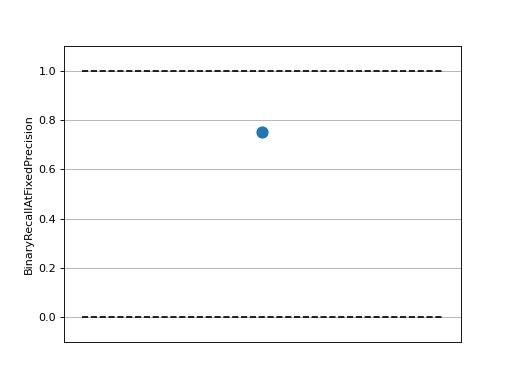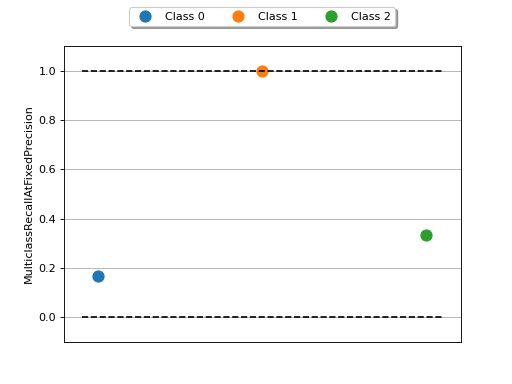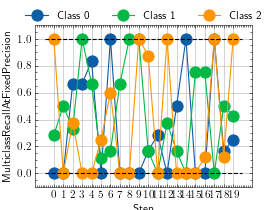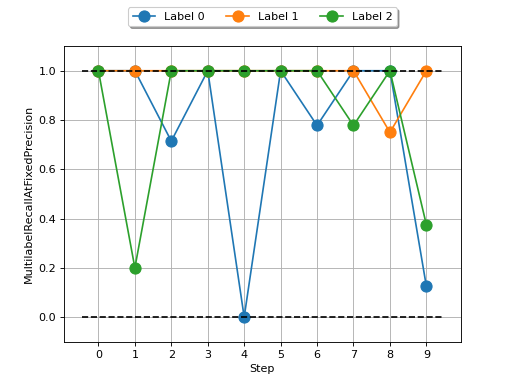Recall At Fixed Precision¶
Module Interface¶
- class torchmetrics.RecallAtFixedPrecision(**kwargs)[source]¶
Compute the highest possible recall value given the minimum precision thresholds provided.
This is done by first calculating the precision-recall curve for different thresholds and the find the recall for a given precision level.
This function is a simple wrapper to get the task specific versions of this metric, which is done by setting the
taskargument to either'binary','multiclass'or'multilabel'. See the documentation ofBinaryRecallAtFixedPrecision,MulticlassRecallAtFixedPrecisionandMultilabelRecallAtFixedPrecisionfor the specific details of each argument influence and examples.
BinaryRecallAtFixedPrecision¶
- class torchmetrics.classification.BinaryRecallAtFixedPrecision(min_precision, thresholds=None, ignore_index=None, validate_args=True, **kwargs)[source]¶
Compute the highest possible recall value given the minimum precision thresholds provided.
This is done by first calculating the precision-recall curve for different thresholds and the find the recall for a given precision level.
As input to
forwardandupdatethe metric accepts the following input:preds(Tensor): A float tensor of shape(N, ...). Preds should be a tensor containing probabilities or logits for each observation. If preds has values outside [0,1] range we consider the input to be logits and will auto apply sigmoid per element.target(Tensor): An int tensor of shape(N, ...). Target should be a tensor containing ground truth labels, and therefore only contain {0,1} values (except if ignore_index is specified). The value 1 always encodes the positive class.
Tip
Additional dimension
...will be flattened into the batch dimension.As output to
forwardandcomputethe metric returns the following output:recall(Tensor): A scalar tensor with the maximum recall for the given precision levelthreshold(Tensor): A scalar tensor with the corresponding threshold level
Note
The implementation both supports calculating the metric in a non-binned but accurate version and a binned version that is less accurate but more memory efficient. Setting the thresholds argument to
Nonewill activate the non-binned version that uses memory of size \(\mathcal{O}(n_{samples})\) whereas setting the thresholds argument to either an integer, list or a 1d tensor will use a binned version that uses memory of size \(\mathcal{O}(n_{thresholds})\) (constant memory).- Parameters:
min_precision¶ (
float) – float value specifying minimum precision threshold.thresholds¶ (
Union[int,list[float],Tensor,None]) –Can be one of:
If set to
None, will use a non-binned approach where thresholds are dynamically calculated from all the data. Most accurate but also most memory consuming approach.If set to an
int(larger than 1), will use that number of thresholds linearly spaced from 0 to 1 as bins for the calculation.If set to an
listof floats, will use the indicated thresholds in the list as bins for the calculationIf set to an 1d
Tensorof floats, will use the indicated thresholds in the tensor as bins for the calculation.
validate_args¶ (
bool) – bool indicating if input arguments and tensors should be validated for correctness. Set toFalsefor faster computations.kwargs¶ (
Any) – Additional keyword arguments, see Advanced metric settings for more info.
Example
>>> from torch import tensor >>> from torchmetrics.classification import BinaryRecallAtFixedPrecision >>> preds = tensor([0, 0.5, 0.7, 0.8]) >>> target = tensor([0, 1, 1, 0]) >>> metric = BinaryRecallAtFixedPrecision(min_precision=0.5, thresholds=None) >>> metric(preds, target) (tensor(1.), tensor(0.5000)) >>> metric = BinaryRecallAtFixedPrecision(min_precision=0.5, thresholds=5) >>> metric(preds, target) (tensor(1.), tensor(0.5000))
- plot(val=None, ax=None)[source]¶
Plot a single or multiple values from the metric.
- Parameters:
val¶ (
Union[Tensor,Sequence[Tensor],None]) – Either a single result from calling metric.forward or metric.compute or a list of these results. If no value is provided, will automatically call metric.compute and plot that result.ax¶ (
Optional[Axes]) – An matplotlib axis object. If provided will add plot to that axis
- Return type:
- Returns:
Figure object and Axes object
- Raises:
ModuleNotFoundError – If matplotlib is not installed
>>> from torch import rand, randint >>> # Example plotting a single value >>> from torchmetrics.classification import BinaryRecallAtFixedPrecision >>> metric = BinaryRecallAtFixedPrecision(min_precision=0.5) >>> metric.update(rand(10), randint(2,(10,))) >>> fig_, ax_ = metric.plot() # the returned plot only shows the maximum recall value by default

>>> from torch import rand, randint >>> # Example plotting multiple values >>> from torchmetrics.classification import BinaryRecallAtFixedPrecision >>> metric = BinaryRecallAtFixedPrecision(min_precision=0.5) >>> values = [ ] >>> for _ in range(10): ... # we index by 0 such that only the maximum recall value is plotted ... values.append(metric(rand(10), randint(2,(10,)))[0]) >>> fig_, ax_ = metric.plot(values)

MulticlassRecallAtFixedPrecision¶
- class torchmetrics.classification.MulticlassRecallAtFixedPrecision(num_classes, min_precision, thresholds=None, ignore_index=None, validate_args=True, **kwargs)[source]¶
Compute the highest possible recall value given the minimum precision thresholds provided.
This is done by first calculating the precision-recall curve for different thresholds and the find the recall for a given precision level.
For multiclass the metric is calculated by iteratively treating each class as the positive class and all other classes as the negative, which is referred to as the one-vs-rest approach. One-vs-one is currently not supported by this metric.
As input to
forwardandupdatethe metric accepts the following input:preds(Tensor): A float tensor of shape(N, C, ...). Preds should be a tensor containing probabilities or logits for each observation. If preds has values outside [0,1] range we consider the input to be logits and will auto apply softmax per sample.target(Tensor): An int tensor of shape(N, ...). Target should be a tensor containing ground truth labels, and therefore only contain values in the [0, n_classes-1] range (except if ignore_index is specified).
Tip
Additional dimension
...will be flattened into the batch dimension.As output to
forwardandcomputethe metric returns a tuple of either 2 tensors or 2 lists containing:recall(Tensor): A 1d tensor of size(n_classes, )with the maximum recall for the given precision level per classthreshold(Tensor): A 1d tensor of size(n_classes, )with the corresponding threshold level per class
Note
The implementation both supports calculating the metric in a non-binned but accurate version and a binned version that is less accurate but more memory efficient. Setting the thresholds argument to
Nonewill activate the non-binned version that uses memory of size \(\mathcal{O}(n_{samples})\) whereas setting the thresholds argument to either an integer, list or a 1d tensor will use a binned version that uses memory of size \(\mathcal{O}(n_{thresholds} \times n_{classes})\) (constant memory).- Parameters:
num_classes¶ (
int) – Integer specifying the number of classesmin_precision¶ (
float) – float value specifying minimum precision threshold.thresholds¶ (
Union[int,list[float],Tensor,None]) –Can be one of:
If set to None, will use a non-binned approach where thresholds are dynamically calculated from all the data. Most accurate but also most memory consuming approach.
If set to an
int(larger than 1), will use that number of thresholds linearly spaced from 0 to 1 as bins for the calculation.If set to an
listof floats, will use the indicated thresholds in the list as bins for the calculationIf set to an 1d
Tensorof floats, will use the indicated thresholds in the tensor as bins for the calculation.
validate_args¶ (
bool) – bool indicating if input arguments and tensors should be validated for correctness. Set toFalsefor faster computations.kwargs¶ (
Any) – Additional keyword arguments, see Advanced metric settings for more info.
Example
>>> from torch import tensor >>> from torchmetrics.classification import MulticlassRecallAtFixedPrecision >>> preds = tensor([[0.75, 0.05, 0.05, 0.05, 0.05], ... [0.05, 0.75, 0.05, 0.05, 0.05], ... [0.05, 0.05, 0.75, 0.05, 0.05], ... [0.05, 0.05, 0.05, 0.75, 0.05]]) >>> target = tensor([0, 1, 3, 2]) >>> metric = MulticlassRecallAtFixedPrecision(num_classes=5, min_precision=0.5, thresholds=None) >>> metric(preds, target) (tensor([1., 1., 0., 0., 0.]), tensor([0.7500, 0.7500, nan, nan, nan])) >>> mcrafp = MulticlassRecallAtFixedPrecision(num_classes=5, min_precision=0.5, thresholds=5) >>> mcrafp(preds, target) (tensor([1., 1., 0., 0., 0.]), tensor([0.7500, 0.7500, nan, nan, nan]))
- plot(val=None, ax=None)[source]¶
Plot a single or multiple values from the metric.
- Parameters:
val¶ (
Union[Tensor,Sequence[Tensor],None]) – Either a single result from calling metric.forward or metric.compute or a list of these results. If no value is provided, will automatically call metric.compute and plot that result.ax¶ (
Optional[Axes]) – An matplotlib axis object. If provided will add plot to that axis
- Return type:
- Returns:
Figure object and Axes object
- Raises:
ModuleNotFoundError – If matplotlib is not installed
>>> from torch import rand, randint >>> # Example plotting a single value per class >>> from torchmetrics.classification import MulticlassRecallAtFixedPrecision >>> metric = MulticlassRecallAtFixedPrecision(num_classes=3, min_precision=0.5) >>> metric.update(rand(20, 3).softmax(dim=-1), randint(3, (20,))) >>> fig_, ax_ = metric.plot() # the returned plot only shows the maximum recall value by default

>>> from torch import rand, randint >>> # Example plotting a multiple values per class >>> from torchmetrics.classification import MulticlassRecallAtFixedPrecision >>> metric = MulticlassRecallAtFixedPrecision(num_classes=3, min_precision=0.5) >>> values = [] >>> for _ in range(20): ... # we index by 0 such that only the maximum recall value is plotted ... values.append(metric(rand(20, 3).softmax(dim=-1), randint(3, (20,)))[0]) >>> fig_, ax_ = metric.plot(values)

MultilabelRecallAtFixedPrecision¶
- class torchmetrics.classification.MultilabelRecallAtFixedPrecision(num_labels, min_precision, thresholds=None, ignore_index=None, validate_args=True, **kwargs)[source]¶
Compute the highest possible recall value given the minimum precision thresholds provided.
This is done by first calculating the precision-recall curve for different thresholds and the find the recall for a given precision level.
As input to
forwardandupdatethe metric accepts the following input:preds(Tensor): A float tensor of shape(N, C, ...). Preds should be a tensor containing probabilities or logits for each observation. If preds has values outside [0,1] range we consider the input to be logits and will auto apply sigmoid per element.target(Tensor): An int tensor of shape(N, ...). Target should be a tensor containing ground truth labels, and therefore only contain {0,1} values (except if ignore_index is specified). The value 1 always encodes the positive class.
Tip
Additional dimension
...will be flattened into the batch dimension.As output to
forwardandcomputethe metric returns a tuple of either 2 tensors or 2 lists containing:recall(Tensor): A 1d tensor of size(n_classes, )with the maximum recall for the given precision level per classthreshold(Tensor): A 1d tensor of size(n_classes, )with the corresponding threshold level per class
Note
The implementation both supports calculating the metric in a non-binned but accurate version and a binned version that is less accurate but more memory efficient. Setting the thresholds argument to
`None`will activate the non-binned version that uses memory of size \(\mathcal{O}(n_{samples})\) whereas setting the thresholds argument to either an integer, list or a 1d tensor will use a binned version that uses memory of size \(\mathcal{O}(n_{thresholds} \times n_{labels})\) (constant memory).- Parameters:
min_precision¶ (
float) – float value specifying minimum precision threshold.thresholds¶ (
Union[int,list[float],Tensor,None]) –Can be one of:
If set to
None, will use a non-binned approach where thresholds are dynamically calculated from all the data. Most accurate but also most memory consuming approach.If set to an
int(larger than 1), will use that number of thresholds linearly spaced from 0 to 1 as bins for the calculation.If set to an
listof floats, will use the indicated thresholds in the list as bins for the calculationIf set to an 1d
Tensorof floats, will use the indicated thresholds in the tensor as bins for the calculation.
validate_args¶ (
bool) – bool indicating if input arguments and tensors should be validated for correctness. Set toFalsefor faster computations.kwargs¶ (
Any) – Additional keyword arguments, see Advanced metric settings for more info.
Example
>>> from torch import tensor >>> from torchmetrics.classification import MultilabelRecallAtFixedPrecision >>> preds = tensor([[0.75, 0.05, 0.35], ... [0.45, 0.75, 0.05], ... [0.05, 0.55, 0.75], ... [0.05, 0.65, 0.05]]) >>> target = tensor([[1, 0, 1], ... [0, 0, 0], ... [0, 1, 1], ... [1, 1, 1]]) >>> metric = MultilabelRecallAtFixedPrecision(num_labels=3, min_precision=0.5, thresholds=None) >>> metric(preds, target) (tensor([1., 1., 1.]), tensor([0.0500, 0.5500, 0.0500])) >>> mlrafp = MultilabelRecallAtFixedPrecision(num_labels=3, min_precision=0.5, thresholds=5) >>> mlrafp(preds, target) (tensor([1., 1., 1.]), tensor([0.0000, 0.5000, 0.0000]))
- plot(val=None, ax=None)[source]¶
Plot a single or multiple values from the metric.
- Parameters:
val¶ (
Union[Tensor,Sequence[Tensor],None]) – Either a single result from calling metric.forward or metric.compute or a list of these results. If no value is provided, will automatically call metric.compute and plot that result.ax¶ (
Optional[Axes]) – An matplotlib axis object. If provided will add plot to that axis
- Return type:
- Returns:
Figure object and Axes object
- Raises:
ModuleNotFoundError – If matplotlib is not installed
>>> from torch import rand, randint >>> # Example plotting a single value >>> from torchmetrics.classification import MultilabelRecallAtFixedPrecision >>> metric = MultilabelRecallAtFixedPrecision(num_labels=3, min_precision=0.5) >>> metric.update(rand(20, 3), randint(2, (20, 3))) >>> fig_, ax_ = metric.plot() # the returned plot only shows the maximum recall value by default

>>> from torch import rand, randint >>> # Example plotting multiple values >>> from torchmetrics.classification import MultilabelRecallAtFixedPrecision >>> metric = MultilabelRecallAtFixedPrecision(num_labels=3, min_precision=0.5) >>> values = [ ] >>> for _ in range(10): ... # we index by 0 such that only the maximum recall value is plotted ... values.append(metric(rand(20, 3), randint(2, (20, 3)))[0]) >>> fig_, ax_ = metric.plot(values)

Functional Interface¶
binary_recall_at_fixed_precision¶
- torchmetrics.functional.classification.binary_recall_at_fixed_precision(preds, target, min_precision, thresholds=None, ignore_index=None, validate_args=True)[source]¶
Compute the highest possible recall value given the minimum precision thresholds provided for binary tasks.
This is done by first calculating the precision-recall curve for different thresholds and the find the recall for a given precision level.
Accepts the following input tensors:
preds(float tensor):(N, ...). Preds should be a tensor containing probabilities or logits for each observation. If preds has values outside [0,1] range we consider the input to be logits and will auto apply sigmoid per element.target(int tensor):(N, ...). Target should be a tensor containing ground truth labels, and therefore only contain {0,1} values (except if ignore_index is specified). The value 1 always encodes the positive class.
Additional dimension
...will be flattened into the batch dimension.The implementation both supports calculating the metric in a non-binned but accurate version and a binned version that is less accurate but more memory efficient. Setting the thresholds argument to
Nonewill activate the non-binned version that uses memory of size \(\mathcal{O}(n_{samples})\) whereas setting the thresholds argument to either an integer, list or a 1d tensor will use a binned version that uses memory of size \(\mathcal{O}(n_{thresholds})\) (constant memory).- Parameters:
min_precision¶ (
float) – float value specifying minimum precision threshold.thresholds¶ (
Union[int,list[float],Tensor,None]) –Can be one of:
If set to
None, will use a non-binned approach where thresholds are dynamically calculated from all the data. Most accurate but also most memory consuming approach.If set to an
int(larger than 1), will use that number of thresholds linearly spaced from 0 to 1 as bins for the calculation.If set to an
listof floats, will use the indicated thresholds in the list as bins for the calculationIf set to an 1d
Tensorof floats, will use the indicated thresholds in the tensor as bins for the calculation.
ignore_index¶ (
Optional[int]) – Specifies a target value that is ignored and does not contribute to the metric calculationvalidate_args¶ (
bool) – bool indicating if input arguments and tensors should be validated for correctness. Set toFalsefor faster computations.
- Returns:
a tuple of 2 tensors containing:
recall: an scalar tensor with the maximum recall for the given precision level
threshold: an scalar tensor with the corresponding threshold level
- Return type:
(tuple)
Example
>>> from torchmetrics.functional.classification import binary_recall_at_fixed_precision >>> preds = torch.tensor([0, 0.5, 0.7, 0.8]) >>> target = torch.tensor([0, 1, 1, 0]) >>> binary_recall_at_fixed_precision(preds, target, min_precision=0.5, thresholds=None) (tensor(1.), tensor(0.5000)) >>> binary_recall_at_fixed_precision(preds, target, min_precision=0.5, thresholds=5) (tensor(1.), tensor(0.5000))
multiclass_recall_at_fixed_precision¶
- torchmetrics.functional.classification.multiclass_recall_at_fixed_precision(preds, target, num_classes, min_precision, thresholds=None, ignore_index=None, validate_args=True)[source]¶
Compute the highest possible recall value given the minimum precision thresholds provided for multiclass tasks.
This is done by first calculating the precision-recall curve for different thresholds and the find the recall for a given precision level.
Accepts the following input tensors:
preds(float tensor):(N, C, ...). Preds should be a tensor containing probabilities or logits for each observation. If preds has values outside [0,1] range we consider the input to be logits and will auto apply softmax per sample.target(int tensor):(N, ...). Target should be a tensor containing ground truth labels, and therefore only contain values in the [0, n_classes-1] range (except if ignore_index is specified).
Additional dimension
...will be flattened into the batch dimension.The implementation both supports calculating the metric in a non-binned but accurate version and a binned version that is less accurate but more memory efficient. Setting the thresholds argument to
Nonewill activate the non-binned version that uses memory of size \(\mathcal{O}(n_{samples})\) whereas setting the thresholds argument to either an integer, list or a 1d tensor will use a binned version that uses memory of size \(\mathcal{O}(n_{thresholds} \times n_{classes})\) (constant memory).- Parameters:
num_classes¶ (
int) – Integer specifying the number of classesmin_precision¶ (
float) – float value specifying minimum precision threshold.thresholds¶ (
Union[int,list[float],Tensor,None]) –Can be one of:
If set to
None, will use a non-binned approach where thresholds are dynamically calculated from all the data. Most accurate but also most memory consuming approach.If set to an
int(larger than 1), will use that number of thresholds linearly spaced from 0 to 1 as bins for the calculation.If set to an
listof floats, will use the indicated thresholds in the list as bins for the calculationIf set to an 1d
Tensorof floats, will use the indicated thresholds in the tensor as bins for the calculation.
ignore_index¶ (
Optional[int]) – Specifies a target value that is ignored and does not contribute to the metric calculationvalidate_args¶ (
bool) – bool indicating if input arguments and tensors should be validated for correctness. Set toFalsefor faster computations.
- Returns:
a tuple of either 2 tensors or 2 lists containing
recall: an 1d tensor of size (n_classes, ) with the maximum recall for the given precision level per class
thresholds: an 1d tensor of size (n_classes, ) with the corresponding threshold level per class
- Return type:
(tuple)
Example
>>> from torchmetrics.functional.classification import multiclass_recall_at_fixed_precision >>> preds = torch.tensor([[0.75, 0.05, 0.05, 0.05, 0.05], ... [0.05, 0.75, 0.05, 0.05, 0.05], ... [0.05, 0.05, 0.75, 0.05, 0.05], ... [0.05, 0.05, 0.05, 0.75, 0.05]]) >>> target = torch.tensor([0, 1, 3, 2]) >>> multiclass_recall_at_fixed_precision(preds, target, num_classes=5, min_precision=0.5, thresholds=None) (tensor([1., 1., 0., 0., 0.]), tensor([0.7500, 0.7500, nan, nan, nan])) >>> multiclass_recall_at_fixed_precision(preds, target, num_classes=5, min_precision=0.5, thresholds=5) (tensor([1., 1., 0., 0., 0.]), tensor([0.7500, 0.7500, nan, nan, nan]))
multilabel_recall_at_fixed_precision¶
- torchmetrics.functional.classification.multilabel_recall_at_fixed_precision(preds, target, num_labels, min_precision, thresholds=None, ignore_index=None, validate_args=True)[source]¶
Compute the highest possible recall value given the minimum precision thresholds provided for multilabel tasks.
This is done by first calculating the precision-recall curve for different thresholds and the find the recall for a given precision level.
Accepts the following input tensors:
preds(float tensor):(N, C, ...). Preds should be a tensor containing probabilities or logits for each observation. If preds has values outside [0,1] range we consider the input to be logits and will auto apply sigmoid per element.target(int tensor):(N, C, ...). Target should be a tensor containing ground truth labels, and therefore only contain {0,1} values (except if ignore_index is specified).
Additional dimension
...will be flattened into the batch dimension.The implementation both supports calculating the metric in a non-binned but accurate version and a binned version that is less accurate but more memory efficient. Setting the thresholds argument to
Nonewill activate the non-binned version that uses memory of size \(\mathcal{O}(n_{samples})\) whereas setting the thresholds argument to either an integer, list or a 1d tensor will use a binned version that uses memory of size \(\mathcal{O}(n_{thresholds} \times n_{labels})\) (constant memory).- Parameters:
min_precision¶ (
float) – float value specifying minimum precision threshold.thresholds¶ (
Union[int,list[float],Tensor,None]) –Can be one of:
If set to
None, will use a non-binned approach where thresholds are dynamically calculated from all the data. Most accurate but also most memory consuming approach.If set to an
int(larger than 1), will use that number of thresholds linearly spaced from 0 to 1 as bins for the calculation.If set to an
listof floats, will use the indicated thresholds in the list as bins for the calculationIf set to an 1d
Tensorof floats, will use the indicated thresholds in the tensor as bins for the calculation.
ignore_index¶ (
Optional[int]) – Specifies a target value that is ignored and does not contribute to the metric calculationvalidate_args¶ (
bool) – bool indicating if input arguments and tensors should be validated for correctness. Set toFalsefor faster computations.
- Returns:
a tuple of either 2 tensors or 2 lists containing
recall: an 1d tensor of size (n_classes, ) with the maximum recall for the given precision level per class
thresholds: an 1d tensor of size (n_classes, ) with the corresponding threshold level per class
- Return type:
(tuple)
Example
>>> from torchmetrics.functional.classification import multilabel_recall_at_fixed_precision >>> preds = torch.tensor([[0.75, 0.05, 0.35], ... [0.45, 0.75, 0.05], ... [0.05, 0.55, 0.75], ... [0.05, 0.65, 0.05]]) >>> target = torch.tensor([[1, 0, 1], ... [0, 0, 0], ... [0, 1, 1], ... [1, 1, 1]]) >>> multilabel_recall_at_fixed_precision(preds, target, num_labels=3, min_precision=0.5, thresholds=None) (tensor([1., 1., 1.]), tensor([0.0500, 0.5500, 0.0500])) >>> multilabel_recall_at_fixed_precision(preds, target, num_labels=3, min_precision=0.5, thresholds=5) (tensor([1., 1., 1.]), tensor([0.0000, 0.5000, 0.0000]))
